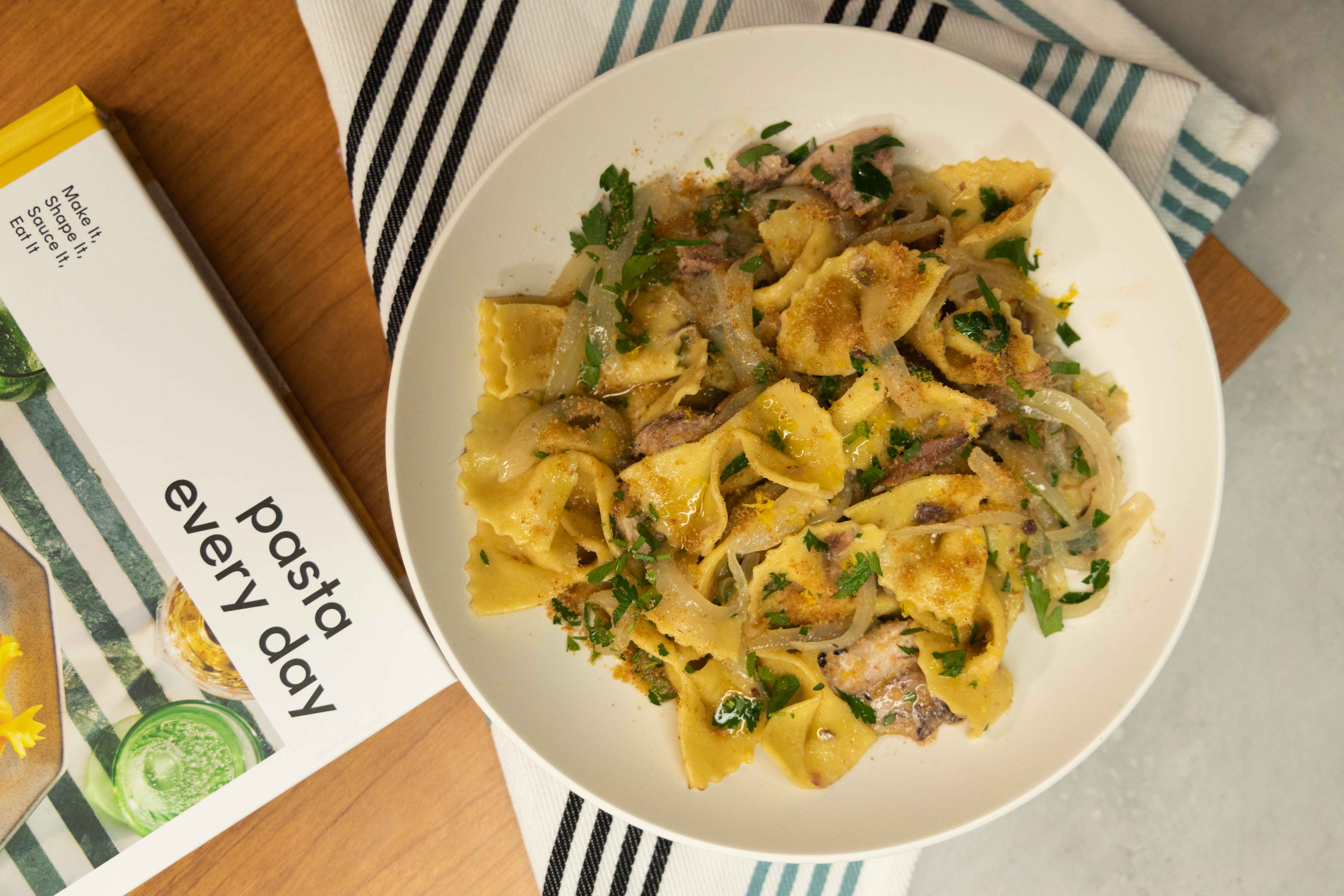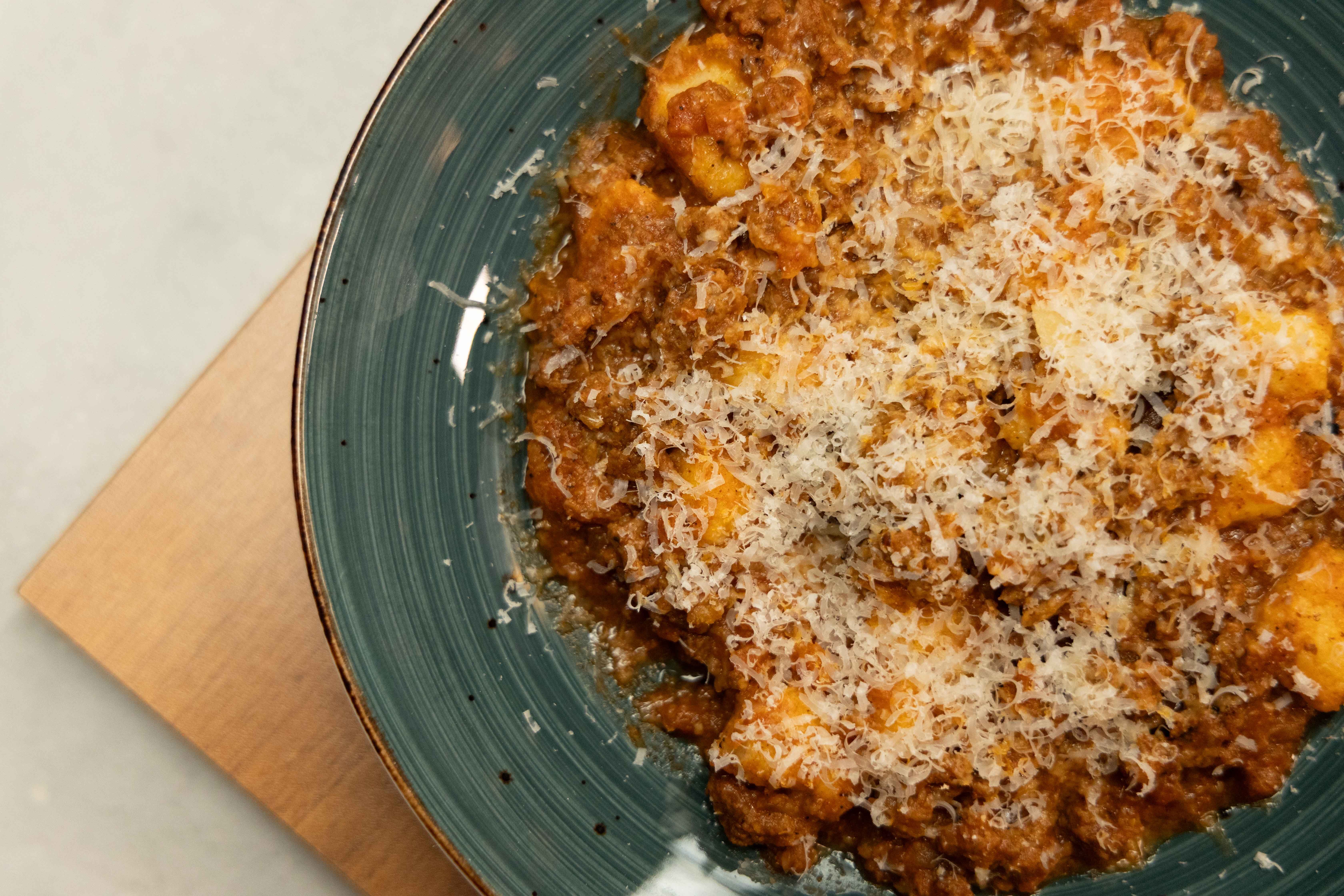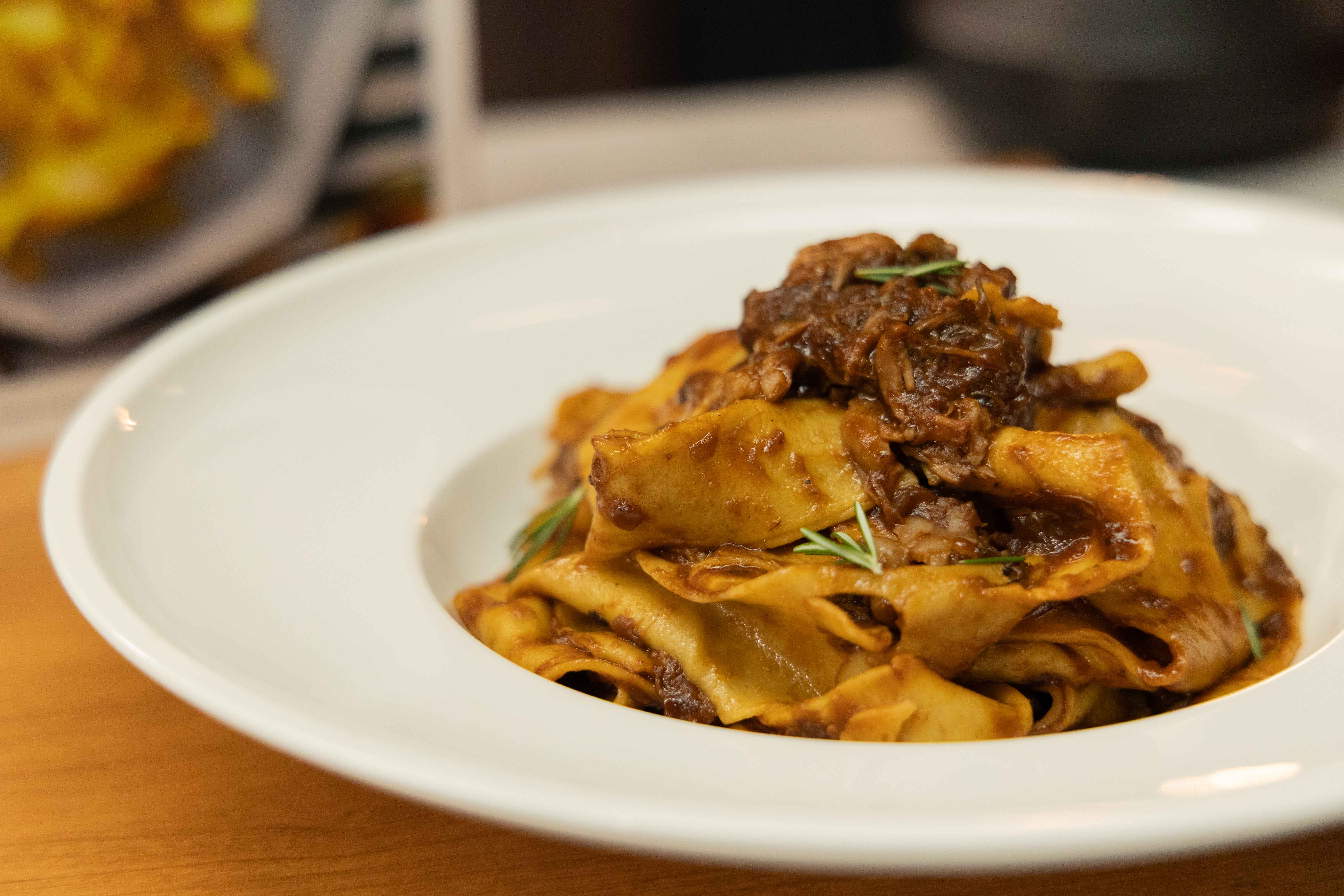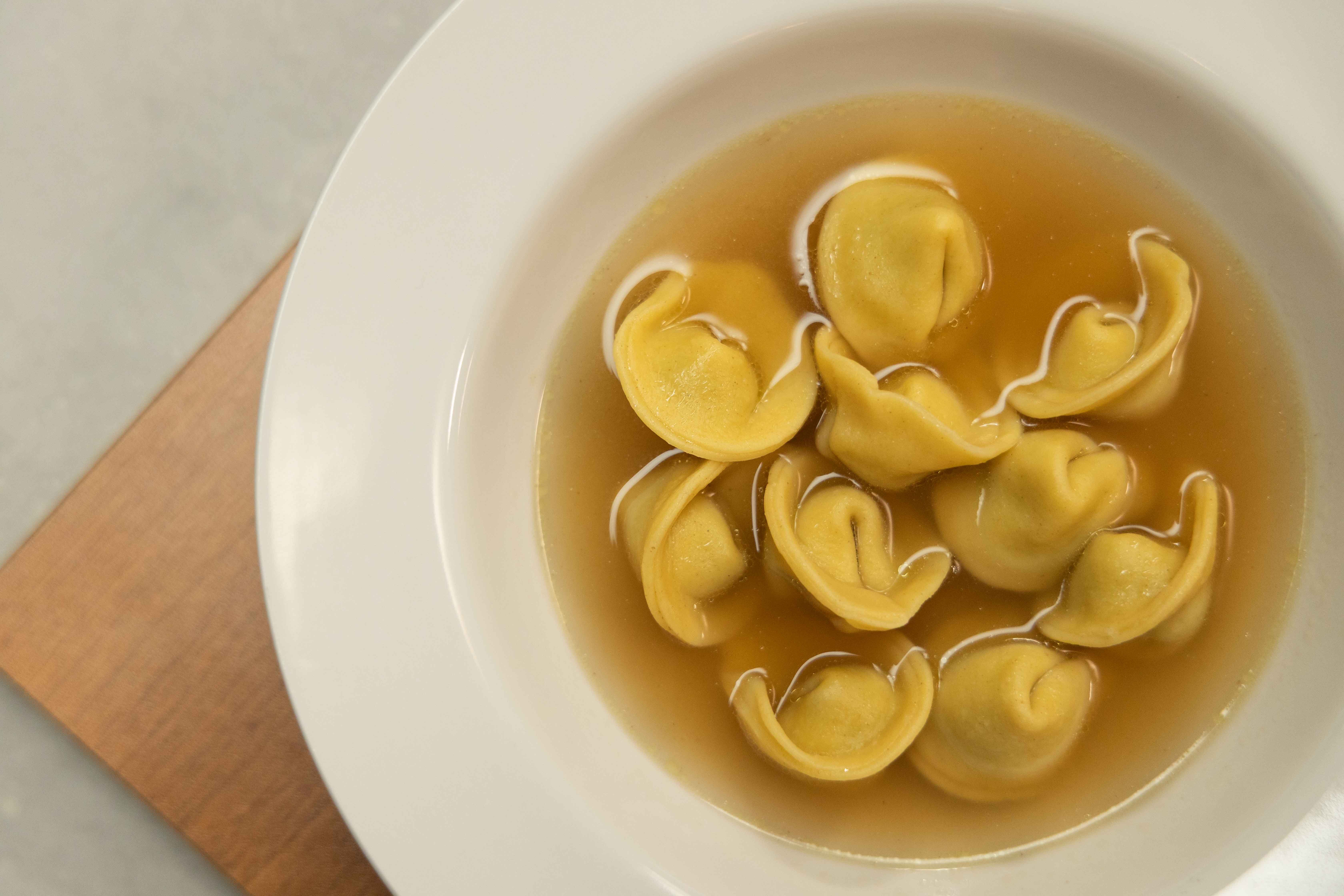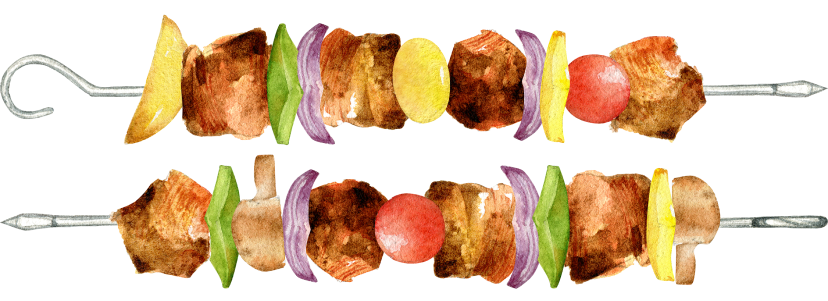Cavatelli and Caramelized Onion Cheese Sauce
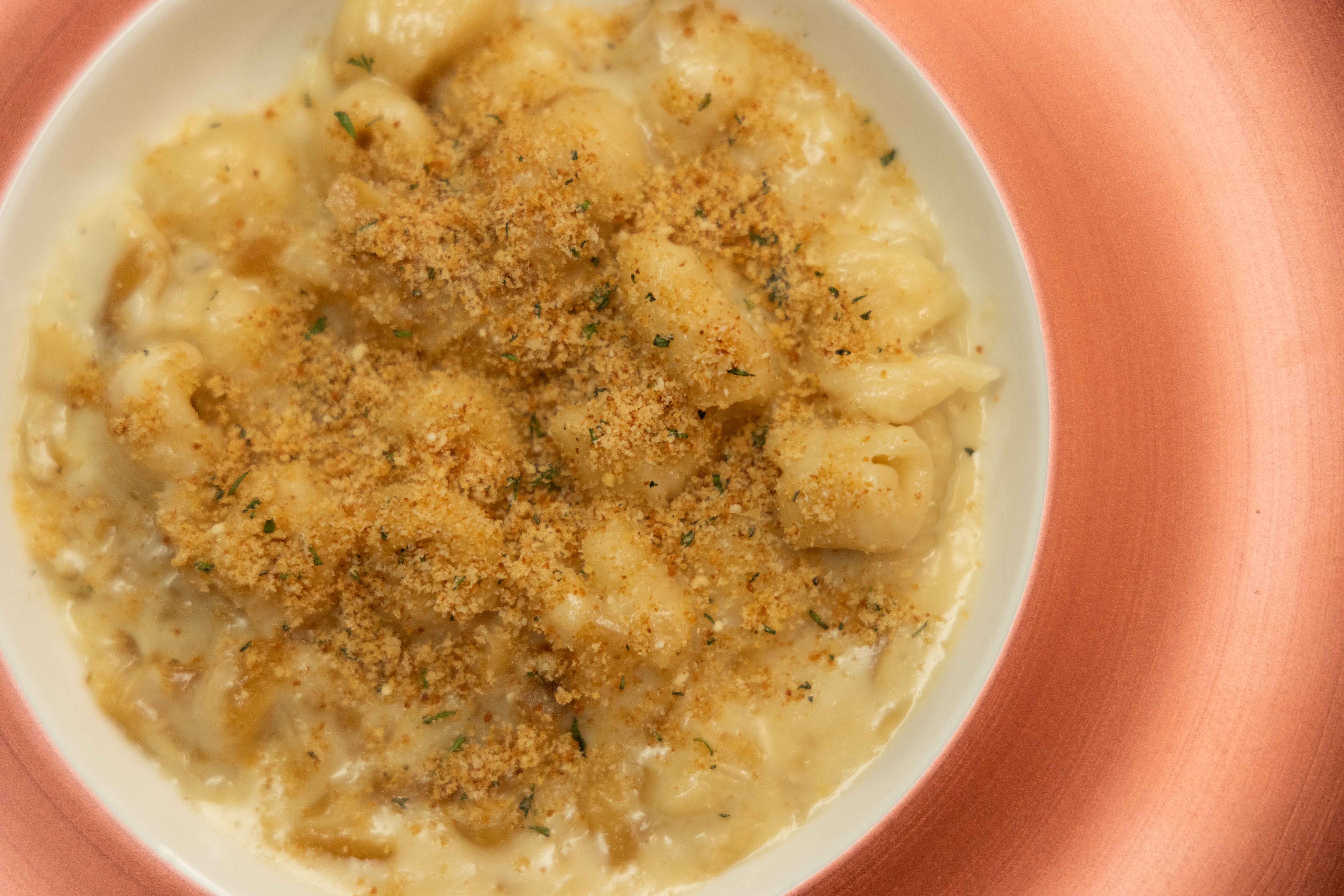
Adapted from PASTA EVERY DAY by Meryl Feinstein. Copyright © 2023 by Meryl Feinstein. Photographs by Nico Schinco. Used with permission of Voracious, an imprint of Little, Brown and Company. New York, NY. All rights reserved.
You can purchase PASTA EVERY DAY here
Cavatelli
Ingredients:
- 400 grams (a generous 2 ½ cups) 00 or all-purpose flour
- 200 ml (¾ cup plus 4 teaspoons) water or tepid water
Method:
- Keep the flour in a bowl (this prevents runaway liquids) or turn it out onto a work surface. Make a wide “well” in the center with your fist, forming a wall of flour tall enough on all sides to contain the liquid. Pour the liquid into the well.
- Using a fork, gradually incorporate a portion of the flour, a couple of teaspoons or so at a time, from the inner rim of the well into the liquid in a circular motion (à la scrambled eggs) until a thick, custardy batter forms. You’ll use only about a quarter of the flour at this point; the majority will remain loose.
- Incorporate the remaining flour into the thickened liquid, either by 1) pulling, folding, and pressing the flour into the center with your hands until becomes a shaggy ball; 2) vigorously whisking the liquid and loose flour together with the fork until all the liquid is evenly distributed (and it looks like little flaky pebbles); or 3) if you’re working on a flat surface, cutting the flour into the liquid with the help of a bench scraper. If it looks like a total mess–sticky her, flaky there– you’re doing it right.
- If you’ve been using a bowl, transfer the mixture to a flat surface, along with any large flaky pieces. It’s also totally normal to have some flour left behind.
- Knead the dough vigorously however works best for you (don’t be shy; you can’t overwork it). I like to push it forward with the heel of my hand, then fold it over on itself about halfway. Do this a few times in one direction, then rotate the dough 90 degrees and repeat, shifting 90 degrees every few strokes. Once the dough starts to come together, brush away any remaining flaky pieces. Always give it time before adding flour or water–- more often than not, it will sort itself out after a few minutes. Then, if the dough still feels dry, add a small amount of water with your fingers to the dry areas and knead until smooth, repeating as necessary; if it feels very soft and sticky, work in more flour until it firms up.
- After about 5 minutes, cover the dough tightly and completely in plastic wrap or under an overturned bowl (you can also clean a shower cap or snug Tupperware container). Let it rest for 5 to 10 minutes—have a cup of coffee, a snack, a glass of wine—then uncover and knead the dough until it’s smooth and firm, pliable but not soft, 3 to 5 minutes more. (This two-part knead makes the dough smoother; if preferred, skip the first rest period and knead the dough for about 10 minutes.)
- When it bounces back from a light touch to the surface, cover the dough tightly and completely once more. Let it rest at room temperature for 20-30 minutes.
- Set up your workspace: Dust a sheet pan with semolina or line it with a dry dishcloth. Gather your tools.
- Roll the dough into a rope, a scant ½ inch (1.25 cm) thick (about the thickness of a Sharpie marker): Start in the center and use your fingers or the palms of your hands to roll the dough, first back and forth, until the surface is smooth, and then outward in opposite directions, eventually making your way toward the ends. If the dough slides and it’s difficult to get a grip, wet your hands a little and try again. The rope does not need to be perfectly even.
- Cut the rope into pieces: Cut the rope into ½ -inch (1.25-cm) pieces, about the size of chickpeas.
- Make the cavatelli: For smooth cavatelli, place your index and middle fingers at the top edge of one of the dough nuggets (the orientation of the dough doesn’t matter, though I usually position the cut sides horizontally). Firmly press down, then drag the dough toward you, with generous pressure, until it curls over and forms a little cave. Don’t be shy: you want to feel tension between your fingers and the dough. The more pressure you use, the hollower it will be, and the more sauce the pasta can grab.
- That’s it— you just made a cavatello!
- If you’re unhappy with the results (perhaps its very thick, or smeared across the board), smush it into a ball and try again. But don’t get bogged down in the details because each piece is meant to be unique.
- To use a gnocchi board or other textured surface, position a nugget of dough near the edge of the board closest to you (near the handle, if it has one). Then press the side of your thumb into the near edge of the dough and push it away from you, with firm pressure, until curls over once and is deeply imprinted with ridges on the outside. If you prefer, use the serrated edge of a table knife or the blade of a bench scraper to drag the dough across the board instead, like spreading butter on bread (some find this option easier, and more satisfying).
- Note: the most obvious choice is to roll the dough across the back of a fork. You can absolutely do this, but in my house a fork doesn’t provide a long enough “runway” to fully roll the pasta, resulting in denser dumplings.
- Arrange the finished cavatelli in a single layer on the prepared sheet pan. Repeat with the remaining pieces, and then the remaining dough. You can leave the pasta uncovered at room temperature until you’re done, for up to 5 hours.
- Cook or store the pasta: Cook the cavatelli until tender but with some bite, 3 to 5 minutes, depending on their thickness and drying time.
Caramelized Onion Cheese Sauce
Ingredients:
- 6 tablespoons (85 grams) unsalted butter, divided
- 3 medium yellow onions, halved and sliced into ¼ inch half moons
- Kosher salt
- ¼ cup (60 ml) aged sherry vinegar or balsamic vinegar
- Freshly ground black pepper
- 1 cup (60 grams) toasted breadcrumbs
- 1 teaspoon stripped fresh thyme, roughly chopped
- 1 ½ teaspoons minced fresh rosemary, from about 1 large sprig
- 2 tablespoons (20 grams) all-purpose flour
- 1 ½ cups (360ml) whole milk
- 3 ½ ounces (100 grams) grated mild white cheddar
- 1 ½ ounces (70 grams) grated Gruyère, Gouda, Comté, or Emmental
Method:
- For the caramelized onions: In a Dutch oven or large, heavy-bottomed sauté pan, melt 4 tablespoons of the butter over medium-high heat. Add the onions and stir until thoroughly coated. Cook, stirring frequently, until the onions are soft and translucent, 15 minutes, then season generously with salt. Reduce the heat to medium-low and continue cooking, stirring every few minutes, until golden— this can take anywhere from 30 to 60 minutes, depending on your stovetop.
- Once the onions start to stick to the bottom of the pan, reduce the heat to low and stir them frequently to prevent burning. If needed, deglaze the pan with a bit of water. Continue to cook, stir, and scrape until the onions are jammy and a rich, deep down.
- When the onions are done, increase the heat to medium and pour in the vinegar. Cook, stirring frequently, until the sharpness has dissipated, 2 to 3 minutes. Season to taste with salt and pepper. Transfer the onions to a bowl.
- For the breadcrumbs: Make the toasted breadcrumbs and stir in the thyme and rosemary while still warm (if using leftover breadcrumbs, gently reheat them in a dry skillet, add the herbs, and stir until fragrant, about 1 minute).
- In the same vessel you used for the onions, melt the remaining 2 tablespoons butter over medium heat. Add the flour and whisk to combine into a paste, scraping up any browned bits from the bottom of the pan. Continue whisking for 1 to 2 minutes until the mixture smells nutty and starts to loosen.
- Add the milk in a thin, steady stream, or a splash at a time, and whisk vigorously to combine. The mixture will get very thick at first but will thin out significantly once all the milk is added. Continue to cook, whisking frequently, until the sauce begins to bubble, then reduce the heat to low and stir until it thickens and coasts the back of a spoon, another minute or two.
- Reduce the heat to low. Add the cheeses in 3 or 4 increments, whisking thoroughly after each addition. Remove from the heat and stir in the caramelized onions. Season to taste.
- To serve: Cook your pasta of choice to your liking. While the pasta cooks, reheat the sauce over medium-low and stir frequently. Add ¼ cup (60 ml) pasta cooking water and stir until smooth and saucy.
- Transfer the pasta directly to the sauce (or drain it first and reserve 1 cup (240 ml) past cooking water) and stir to combine, loosening with more cooking water as needed. Divide the pasta among bowls and serve with plenty of breadcrumbs and black pepper.

